-
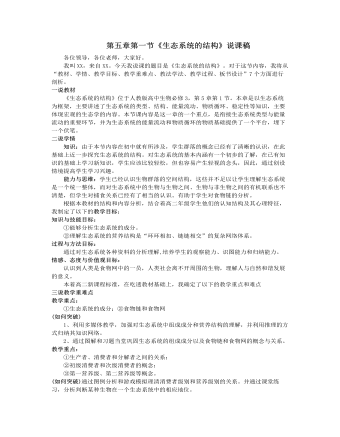
人教版高中生物必修3第五章第一节《生态系统的结构》说课稿
5、归纳小结,当堂演练(10分钟)1、肉食动物不可能是一条食物链中的第几营养级()A.第五B.第二C.第三D.第四2、对水稻→鼠→蛇→鹰这条食物链的错误描述是()A.水稻是生产者B.鼠是初级消费者C.蛇是次级消费者D.鹰属于第三营养级3、在下列生物中,属于分解的是()A.蓝藻B.草履虫C.蘑菇D.蝗虫4、从生态系统的组成成分看,硝化细菌和蚯蚓属于()A.生产者和分解者B.生产者和消费者C.消费者和分解者D.分解者和消费者5、下列哪组生物可和无机环境组成一个生态系统()A.水藻、鸟B.小鱼、大鱼C.小草、昆虫、细菌D.水藻、虾6、对草→昆虫→食虫鸟→鹰这条食物链的叙述,正确的是()A.有四个营养级,两个次级消费者B.有三个营养级,一个生产者C.食虫鸟是第三营养级、次级消费者D.有三个营养级,三个消费者(设计意图)进行简单扼要的课堂小结与练习,可以把课堂传授的知识尽快地转化为学生的素质;也可使学生更深刻地理解理论在实际生活中的应用。
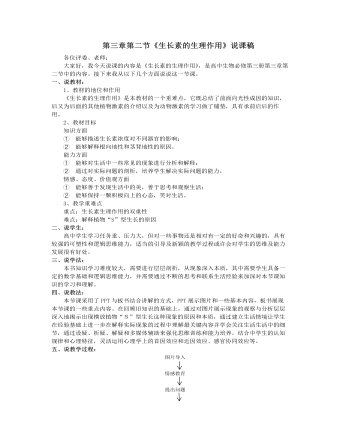
人教版高中生物必修3第三章第二节《生长素的生理作用》说课稿
强调重力对生长素分布的影响,为下面的内容讲解做铺垫,明确植物出现向光性与生长素分布不均有关。复习旧知识,产生首因效应,巩固和加强记忆。通过植物向光性是生长素分布较多而促进生长,进而提出“对于植物来说,生长素是不是越多越好”这个问题,引发思考,锻炼思维。说明生长素浓度对不同器官产生的影响不同,让学生对这一情况有一个整体印象。结合数学知识逐步分析图上各点和各曲线的含义,引导学生得出不同器官对生长素浓度的敏感性顺序,为解释横放植物“S”型生长做铺垫。通过对曲线的分析,得出低生长素浓度起促进作用,高浓度有抑制作用这种双重性,并得出其双重性表现。通过以上的分析和总结,对横放植物“S”型生长进行解释,达到首尾呼应的效果。采用“蒙太奇”手法,引申到“太空中,横放植物将会如何生长”这个问题,引发学生的联想和思考,以这种提问方式结课为下节课的开课做了铺垫,掌握了主动权。
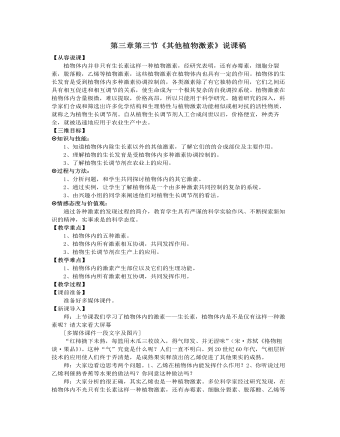
人教版高中生物必修3第三章第三节《其他植物激素》说课稿
二、应用生长调节剂的注意事项1、效果不稳定。2、使用时期。3、使用浓度和方法。4、使用生长调节剂仅是葡萄栽培管理的辅助手段,不能盲目孤立地依赖生长调节剂。生2:我们小组查的资料是关于小麦使用生长调节剂。小麦应用植物生长调节剂,可以调节植株的生长发育,具有控旺促壮、增强抗逆性、增加粒重、提高产量并有利于优质、早熟等多重效果。生3:我找了一篇生长调节剂对矮牵牛大型穴盘生产。师:上面三位同学利用课下的时间,在网上查的三段文字都相当的不错,大家可以从中学到一些书本上没有的知识,请大家结合刚刚三位同学的三段文字以及自己平时所积累的知识,讨论以下几个问题。师:你知道哪些农产品在生产过程中使用了植物生长调节剂?师:哪些水果在上市前有可能使用了乙烯利?师:生产过程中施用植物生长调节剂,会不会影响农产品的品质?师:如果你是水果销售员,面对半青不熟的水果,你认为应当使用乙烯利催熟吗?作为一个消费者,你又怎么看?
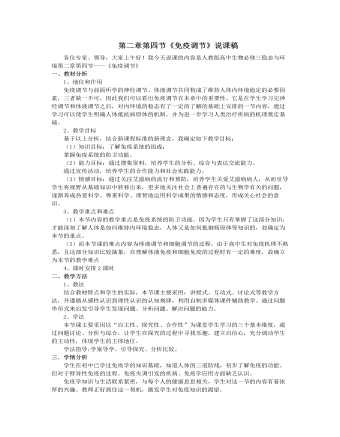
人教版高中生物必修3第二章第四节《免疫调节》说课稿
(四)、活动交流,体验科学通过资料分析讨论以下三个问题:1、你知道爱滋病的传播途径吗?2、如何预防爱滋病?3、我们应如何对待爱滋病患者?面对艾滋病我们能做些什么?从而进入情感态度的教育。除此之外,我还设计一个开放性的作业“向全社会为关注艾滋病设计一个宣传广告”(形式不限,漫画、板书、倡议书等),让学生把爱心付诸于实际行动。在此基础上引出“免疫学的应用”从免疫预防、免疫治疗、器官移植三个方面讲述,让学生充分体验到知识和社会生活的紧密联系,让他们不在感到科学是那么的遥远,而是可爱的有用的。通过交流,让同学们体会到合作的魅力和重要性,进一步培养合作意识和合作能力。最后我设计一个资料搜集,让同学们选一个感兴趣的主题利用电脑在网上搜集有关资料。主题:1、你知道世界艾滋病日吗?历年的主题是什么?开展世界艾滋病运动有什么意义?
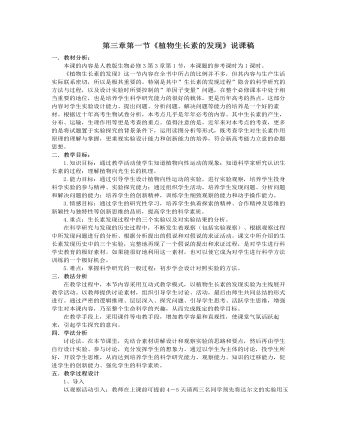
人教版高中生物必修3第三章第一节《植物生长素的发现》说课稿
(5)根据实验的第五部分——验证性实验结果,证实了达尔文关于植物向光性运动原因的假说――确实存在一种物质致使胚芽尖端产生了向光运动。这样通过多个实验的多媒体演示过程,强化学生的思维,最终在学生的大脑中形成科学研究过程的”条件反射”。为了使学生初步学会”设计对照实验的方法”,首先也利用多媒体的演示实验,并在其中特意设置一些”陷阱”,通过多次”请学生进入‘陷阱’”,来强化设计实验时应该控制的变量问题,从而在学生的认知领域里初步构建出设计对照实验的知识体系。3、归纳总结1934年,荷兰科学家郭葛等人从植物中分离出了这种能使植物产生向光性的物质,并确定它就是吲哚乙酸。这就真正从化学物质的角度证实了达尔文的假设。在能够从植物体中分离提取出生长素之后,要想知道:除了能使植物产生向光运动之外,生长素对于植物的器官还有什么作用?可以采用哪种方法来进行试验?
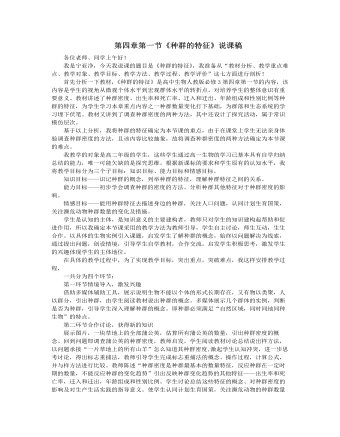
人教版高中生物必修3第四章第一节《种群的特征》说课稿
第二环节合作讨论,获得新的知识展示图片,一块草地上的全部蒲公英,估算所有蒲公英的数量,引出种群密度的概念。回到问题即调查蒲公英的种群密度,教师启发,学生阅读教材讨论总结说出样方法,以问题承接“一片草地上的所有山羊”怎么知道其种群密度,激起学生认知冲突,进一步思考讨论,得出标志重捕法,教师引导学生完成标志重捕法的概念、操作过程,计算公式,并与样方法进行比较。教师陈述“种群密度是种群最基本的数量特征,反应种群在一定时期的数量,不能反应种群的变化趋势”引出反映种群变化趋势的其他特征——出生率和死亡率,迁入和迁出,年龄组成和性别比例。学生讨论总结这些特征的概念、对种群密度的影响及对生产生活实践的指导意义。使学生认同计划生育国策,关注濒危动物的种群数量变化。之后引导学生构建种群特征的关系图。再简明阐述种群空间特征即:随即分布,均匀分布、集群分布。第三环节反馈练习,巩固新知识通过对学生练习结果的评价,了解学生对知识的掌握情况。即以学生为核心的教学评价。
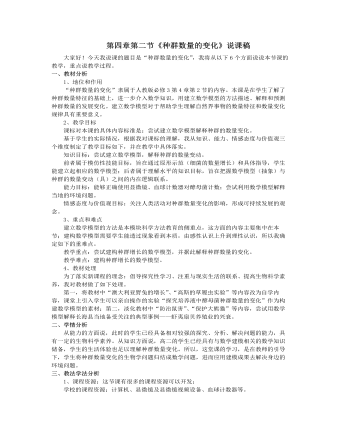
人教版高中生物必修3第四章第二节《种群数量的变化》说课稿
4、种群数量变化的其他类型我结合“种群数量下降”这个知识点对学生进行寓教。现今的自然界,许多野生生物种群的数量都在下降,为什么呢?我提供了世界人口近2000年的种群增长曲线,一切都在不言而喻中。现今社会的主题是呼吁建立和谐社会,作为生物老师,我想它不应该仅仅指人与人之间的和谐,也不应该仅仅指人与社会之间的和谐,它更应该昭示着人与自然之间的和谐,人类只有学会与自然和谐相处,才能在生物圈中享受最大的幸福。6、小结课程在实验的大背景下展开,也在实验的背景中结束,这里可以呈现出一个完整的探究思路。同时,学生思考如何实现多种预期过程,相当于对本课进行小结。五、效果预测课堂上选取的内容基于学生的生活体验,创设的情境能激发学生的兴趣,设置的问题符合学生的认知水平,有助于学生能力的提高,教学目标可以基本实现。
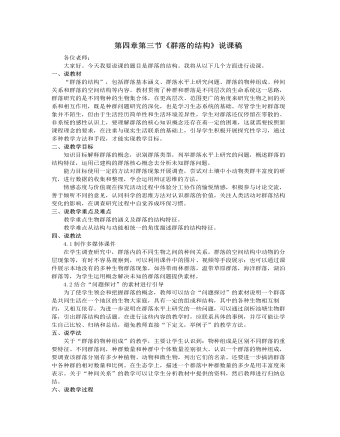
人教版高中生物必修3第四章第三节《群落的结构》说课稿
建构群落特征3群落有一定的空间结构,包括垂直结构和水平结构。思维拓展从结构与功能相统一的角度思考群落内的分层结构的意义。6.4运用群落核心知识概念解决未知群落问题学生已掌握了同一时间内聚集在一定区域中各种生物种群的集合是生物群落,所有群落都有一定的物种组成、种间关系、空间结构,不同群落主要表现在其具体特征上的差异。在此基础上,为学生提供新的问题情境,利用多媒体课件,展示不同生态环境下不同生物群落问题,让学生运用已建构的群落概念,通过分析、演绎和具体化等辩证思维的过程解决未知的群落问题,课件展示热带雨林、温带草原、海洋、湖泊等生物群落。学生运用概念说明不同的群落的物种丰富度差异,列举不同群落的种间关系,分析不同群落的垂直结构和水平结构,研究造成不同群落重要特征差异的原因。评价人类的活动对群落的结构的影响。
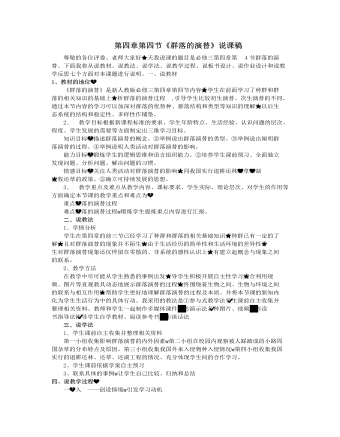
人教版高中生物必修3第四章第四节《群落的演替》说课稿
总结与大自然和谐相处走可持续发展道路。在我们的努力下地球一定能为我们人类提供更好的生存环境这部分的设计意图是培养学生综合实践能力把新知识内化为学生生活行为中的具体行动。五、说板书设计这样设计能直观形象地体现知识结构、突出重点难点、利于巩固新知识。六、说作业设计1、课本P80练习——常规作业主要为巩固和落实认知目标服务。2、活动与探究以“警惕外来物种入侵”为题写一篇科普文章。——开放性作业学生在自主完成任务的同时可以相互合作通过自主学习所获得的成果经共享共同整理、归纳、分类得到一种比较完整的答案。七、说教学反思1、本节教学过程主要重视运用“动态发展观”来组织实施教学用历史性的眼光从纵向进行寻踪综合利用视频、图片等直观教具动态地展示群落演替的过程帮助学生更好地理解群落演替的过程及本质。
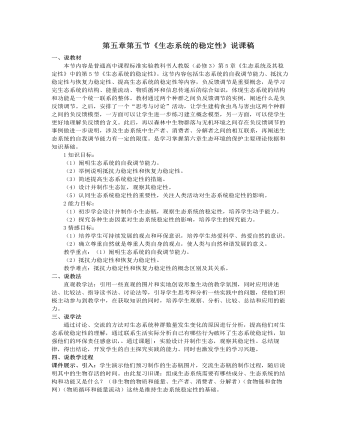
人教版高中生物必修3第五章第五节《生态系统的稳定性》说课稿
主要让学生明确以下观点:(1)自然生态系统是人类生存的基本环境;(2)人类活动的干扰正在全球范围内使生态系统偏离稳定状态;(3)人类生存与发展的命运就掌握在自己手中,但又受到自然规律的制约。反思总结,练习巩固:对本节知识点进行回顾,整理出简要的知识主线,为学生系统性复习巩固提供思路,课件展示老师课前收集准备的相关练习题,指导学生完成练习题,加学生深对本节知识的理解把握。结课布置作业:我们已经学习了生态系统的稳定性,那么,生态系统的各种功能之间的关系是怎样的呢?在下一节课我们一起来学习这一方面的内容。这节课后大家可以先预习这一部分,着重分析他们之间的关系。并完成本节的课后练习及课后延伸拓展作业。达到对本节内容知识的巩固提高和延展的目的。八、板书设计第五节生态系统的稳定性一、 生态系统的稳定性概念1.概念:生态系统所具有的保持或恢复自身结构和功能相对稳定的能力,
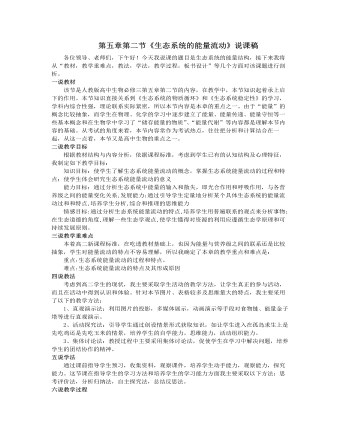
人教版高中生物必修3第五章第二节《生态系统的能量流动》说课稿
为使学生对知识达到深化理解、巩固提高的效果,我结合两个讨论题专门设计了一组即时训练题,做完后,屏幕展示汇总,以及时巩固新知。然后,进行当堂训练,这部分习题分AB两个层次,适合不同能力的学生做,做完后收上,课后批改后会了解学生掌握的情况,从而得到准确的学习信息。这部分用时约6分钟。三)结课组织学生总结本节课。引导学生可对照教学目标总结知识,从而尽快将知识形成能力;也可总结方法,从而理解生物学分析思路;还可以谈谈感想,从而理解人与自然的和谐相处的必要性。最后要求学生完成课后习题,课后时间允许的话还可组织有兴趣的同学进行对当地农田生态系统的能量流动情况得调查。这部分用时大约4分钟。七说板书设计生态系统的能量流动一概念:生态系统中能量的输入,传递和散失过程

人教版高中生物必修3第五章第三节《生态系统的物质循环》说课稿
步骤四:展示点评、质疑探究展示小组展示讨论论成果,要求每组B、C层次学生进行展示。展示结束后由点评同学对展示结果进行点评,要求先点评对错;再点评思路方法和应注意的问题。既要有结论,又要有分析,力争有相关的总结和拓展。下面的同学注意倾听、思考,关键内容做好笔记,有补充或不明白的地方及时、大胆提出,力争全部过关,解决疑难点。根据学生点评结果,教师适当点评拓展。步骤五:拓展提升、总结升华简单扼要的课堂小结,系统回顾知识,强化学生对于生态系统物质循环的认识。环节三:课后检测布置训练内容,巩固知识。五、课后反思:本堂课采用我校163高效课堂模式,通过小组合作探究、展示自我、互相点评的方式完成整堂课的教学内容,充分突出了新课标中以学生为主体的指导思想。教学过程中,依据学生的个性差异,提出不同要求,布置不同任务,让不同层次的学生都能参与其中,调动全体学生的积极性,促进全体学生的发展。
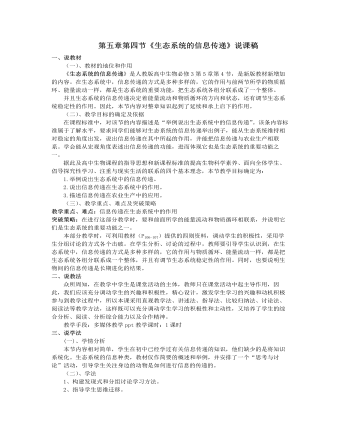
人教版高中生物必修3第五章第四节《生态系统的信息传递》说课稿
教师通过引导学生看课本的“资料分析”,要求学生从中得出生态系统中的信息传递在生态系统中的作用。学生通过分析、讨论可以得出结论,这时教师要适时的点拨,给予小结,并引导学生站在整个生态系统的角度去分析信息传递,并和能量流动、物质循环联系在一起,说明它们都是生态系统各组分必不可少的一部分,同时指出信息传递是长期的生物进化的结果。学生了解了生态系统中信息传递的作用后,教师适时进行话题的转移,“我们学习信息传递,是为了更好的利用它,谁能说出信息传递在我们生产和生活中应用方面的例子”?学生们这时就开始讨论了,他们可能做不出正确的回答,但他们却能举出生活中有关信息传递的许多例子。讨论几分钟后,让看看信息传递在农业生产中有哪些应用吧?使教学回归课本,使知识得以沉淀,形成自己牢固的知识体系。(依时可以安排学生自学)

新人教版高中英语必修1Unit 1 Teenage Life-Listening and Speaking & Listening and Talking教案
Step 2 Listening and Talking1. The teacher is advised to talk with their new students about the related topic: Boys and girls, do you know some structures to talk about future activities? Talking about future activitiesWe’ll …I plan to …There’ll be …I hope to …We’re going to …2. After their small talk, the teacher can move on by playing the listening and solve the following task.Underline the expressions in the sentences below Cao Jing and Max use to talk about the future.We’ll learn useful skills.I plan to improve my spoken English.There’ll be students from different schools.I hope to make new friends.We’ll talk about teenage life.I’ll learn to make a fire.There’ll be students from different countries at the camp.There’ll be some experts there to show us how to live in the wild.We’re going to learn about wildlife.I’m going to give a speech.I think I’m going to enjoy the activities.I think we’ll have a lot of fun.3. Work in groups. Plan a youth camp.Teacher make the Ss think of ideas for the camp. And they can use the questions below to get started. And have the Ss present their ideas for a youth camp to the class.●What kind of camp is it?●Who will be there?●What will they do?●What will they learn?
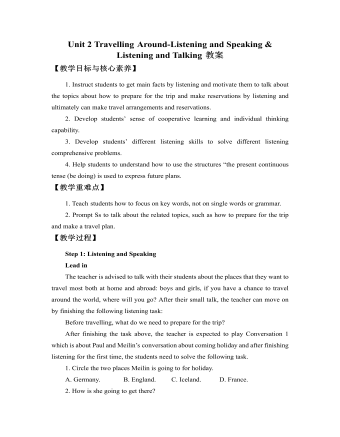
新人教版高中英语必修1Unit 2 Travelling Around-Listening and Speaking & Listening and Talking教案
【教学目标与核心素养】1. Instruct students to get main facts by listening and motivate them to talk about the topics about how to prepare for the trip and make reservations by listening and ultimately can make travel arrangements and reservations. 2. Develop students’ sense of cooperative learning and individual thinking capability. 3. Develop students’ different listening skills to solve different listening comprehensive problems.4. Help students to understand how to use the structures “the present continuous tense (be doing) is used to express future plans.【教学重难点】1. Teach students how to focus on key words, not on single words or grammar.2. Prompt Ss to talk about the related topics, such as how to prepare for the trip and make a travel plan.【教学过程】Step 1: Listening and SpeakingLead inThe teacher is advised to talk with their students about the places that they want to travel most both at home and abroad: boys and girls, if you have a chance to travel around the world, where will you go? After their small talk, the teacher can move on by finishing the following listening task:Before travelling, what do we need to prepare for the trip?
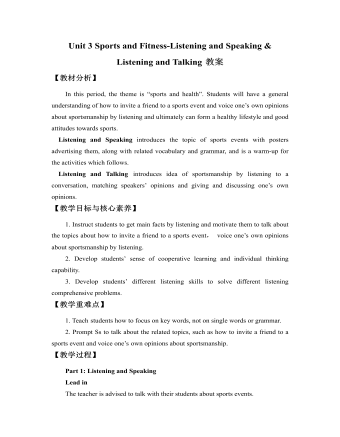
新人教版高中英语必修1Unit 3 Sports and Fitness-Listening and Speaking & Listening and Talking教案
Finally, after finishing the task above, the teacher is expected to instruct students to work in groups to finish the following project:Speaking ProjectWhat event or activity would you like to invite your friend to? Make a conversation with a partner.Ski Race: Zhangjiakou, a beautiful city in northern China, will host the Youth Ski Race in December.Track Meet: a great event for track –and –field lovers on 26 October.Gym Class: come and work out at a gym! You can make it.Part 2: Listening and Talking:The teacher is advised to talk with their new students about the related topic: Boys and girls , what do you think of sportsmanship? Let’s listen and find out:Play the listening and match each opinion with the right speaker. Who do you agree with? Why?Cao Jing _____________ Lily _____________ Max _____________A. An athlete should do his/her best to win.B. The girl should stop and help the other girl. Good sportsmanship is more important than wining!C. An athlete should think about honor and his/her fans if he/she is competing for his/her country.Listen again and circle the expressions that you hear in the conversation.
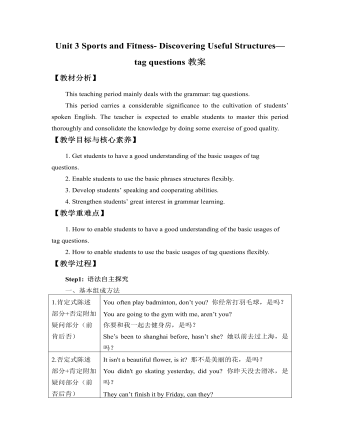
新人教版高中英语必修1Unit 3 Sports and Fitness- Discovering Useful Structures—tag questions教案
【教材分析】This teaching period mainly deals with the grammar: tag questions.This period carries a considerable significance to the cultivation of students’ spoken English. The teacher is expected to enable students to master this period thoroughly and consolidate the knowledge by doing some exercise of good quality.【教学目标与核心素养】1. Get students to have a good understanding of the basic usages of tag questions.2. Enable students to use the basic phrases structures flexibly.3. Develop students’ speaking and cooperating abilities.4. Strengthen students’ great interest in grammar learning.【教学重难点】1. How to enable students to have a good understanding of the basic usages of tag questions.2. How to enable students to use the basic usages of tag questions flexibly.【教学过程】Step1: 语法自主探究一、基本组成方法1.肯定式陈述部分+否定附加疑问部分(前肯后否) You often play badminton, don’t you? 你经常打羽毛球,是吗?You are going to the gym with me, aren’t you?你要和我一起去健身房,是吗?She’s been to shanghai before, hasn’t she? 她以前去过上海,是吗?2.否定式陈述部分+肯定附加疑问部分(前否后肯) It isn't a beautiful flower, is it? 那不是美丽的花,是吗?You didn't go skating yesterday, did you? 你昨天没去滑冰,是吗?They can’t finish it by Friday, can they?他们不能在星期五之前完成,是吗?

新人教版高中英语必修3Unit 1 Festivals and celebrations-Discovering Useful Structure教学设计
4.That was an experience that frightened everyone. →That was _____________________. 答案:1. taking 2. being discussed 3. in the reading room 4. a frightening experienceStep 6 The meaning and function of V-ing as the predicative动词-ing形式作表语,它通常位于系动词后面,用以说明主语“是什么”或“怎么样”一种表示主语的特质、特征和状态, 其作用相当于形容词; 另一种具体说明主语的内容, 即主语等同于表语, 两者可互换。The music they are playing sounds so exciting. 他们演奏的音乐听起来令人激动。The result is disappointing. 结果令人失望。Our job is playing all kinds of music. 我们的工作就是演奏各种音乐。Seeing is believing. 眼见为实。Step 7 Practice1. It is ________(amaze) that the boy is able to solve the problem so quickly.2. Buying a car is simply _______(waste) money. 3. Please stop making the noise—it’s getting ________(annoy). 4. complete the passage with the appropriate -ing form.La Tomatina is a festival that takes place in the Spanish town Bunol every August. I think many food festivals are __________ because people are just eating. however, this festival is _________ because people don't actually eat the tomatoes. Instead, they throw them at each other! the number of people ________ part in this tomato fight, can reach up to 20,000, and it is a very __________ fight that lasts for a whole hour. The _______ thing is how clean Bunol is after the tomatoes are washed away after the fight. this is because the juice form tomatoes is really good for making surfaces clean!答案:1. amazing 2. wasting 3. annoying4. boring interesting taking exciting amazing

新人教版高中英语必修3Unit 1 Festivals and Celebrations-Reading and Thinking教学设计
The topic of this part is “Discover the reasons for festivals and celebrations.The Listening & Speaking & Talking part aims at talking about the experiences and feelings or emotions about the festivals and celebrations. This section aims at detecting the reason why the people celebrate the festivals, the time, the places, the types and the way of celebrations. It also explains why some traditions in the old celebrations are disappearing, like the firecrackers in the big cities and some new things are appearing like the prosperity of business or commerce. 1. Students can talk about what festivals they know and the reasons and the way of celebrating them.2. Students should learn the reading skills such as the headline and get the topic sentences, the structures of articles.3. Students can understand the past, the present situation of some festival around the world and why there are some changes about them. 4. Students can have the international awareness about the festivals.1. Students should learn the reading skills such as the headline and get the topic sentences, the structures of articles.2. Students can understand the past, the present situation of some festival around the world and why there are some changes about them.Step 1 Lead in---Small talkWhat festival do you like best ? Why ?I like the Spring Festivals because I can set off the fireworks, receive the lucky money and enjoy the Gala with my families.Step 2 Before reading---Pair workWhy do people celebrate different festivals ?The Spring Festivals is to celebrate the end of winter and the coming of spring and new life.The Mid-autumn Day is to celebrate the harvest and admire the moon.

新人教版高中英语必修3Unit 1 Festivals and Celebrations-Listening &Speaking&Talking教学设计
The theme of this section is “Talk about festival activities and festival experiences”.Festival and holiday is a relaxing and interesting topic for students. This part talks about the topic from the daily life of students’. In the part A ---Listening and Speaking, there are three conversations among different speakers from three countries(Japan, Rio and China), where the speakers are participating in or going to participate in the festivals and celebrations. So listening for the relationship among them is a fundamental task. Actually, with the globalization and more international communication, it is normal for Chinese or foreigners to witness different festivals and celebrations in or out of China. In the Conversation 1, a foreign reporter is interviewing a Japanese young girl who just had participated in the ceremony of the Coming-of-Age Day on the street and asking her feeling about the ceremony and the afterwards activities. Conversation 2, Chinese girl Li Mei is witnessing the Rio Carnival for the first time, and her friend Carla gives her some advice on the costumes which enables her to match with the carnival to have a good time. Conversation 3, a Chinese guide is showing a group of foreign visitors around the Lantern Festival and introducing the customs of the festival to them. The three conversations have a strong vitality and insert the festival and cultural elements from different countries. So perceiving the festivals and cultures from different countries is the second task. At the same time, the scripts also insert the targeted grammar --- v-ing as attributive and predicative, which students can perceive and experience in a real context and make a road for the further study. That is the third task. In the Part B--- Listening and Talking, the theme is “Talk about festival experience”, which is the common topic in our daily conversations. During the conversation, Song Lin, a Chinese student, asked Canadian friend Max about how to spend Christmas. In the conversation, Song Lin talked about experience and the feelings during the Chinese Spring Festival, during which there are not only some enjoyable things but some unpleasant things. After the listening, perhaps students find there are some similarities between Christmas and the Chinese Spring Festival as there are some differences in the origins and celebrations. For example, people always visit friends and relatives, decorate their houses, have a big dinner together, chat and give presents to each other.